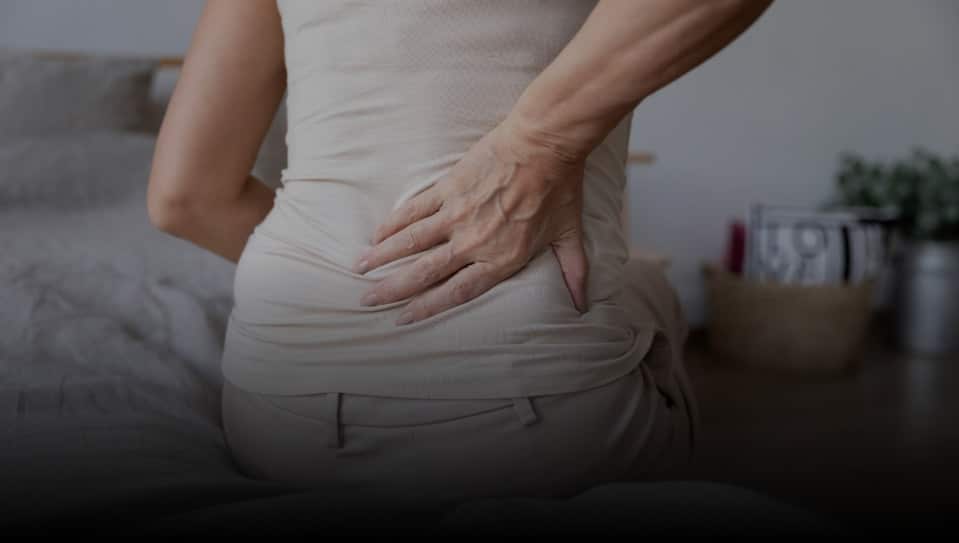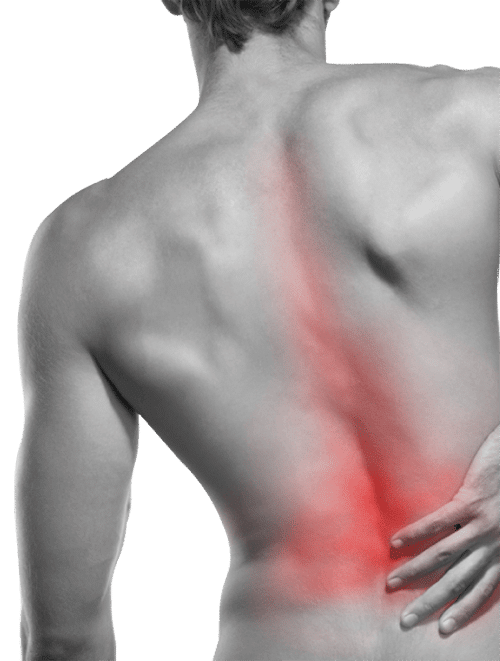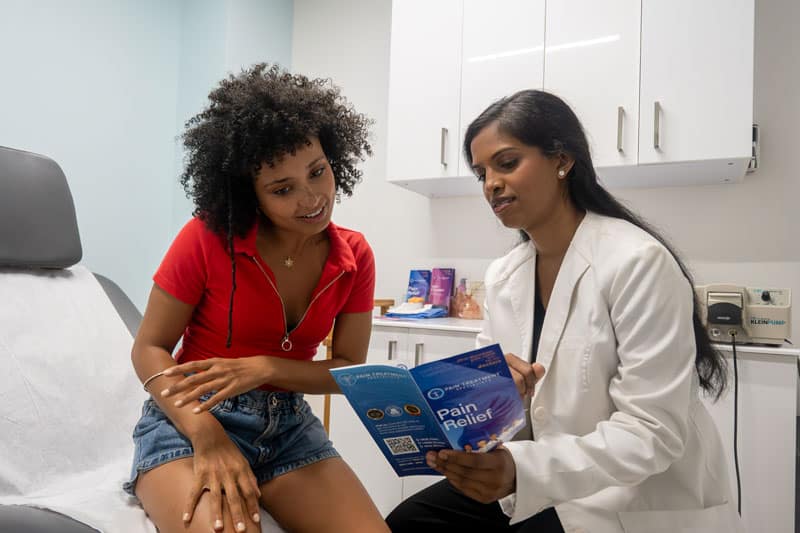If you’ve ever experienced chronic back pain, you know how debilitating it can be. Not only does it affect your physical well-being, but it can also have a significant impact on your overall health. Chronic back pain affects millions of people worldwide. It is typically defined as pain that persists for more than 12 weeks, often originating from the spine, muscles, nerves, or other structures in the back. While acute back pain can result from injuries or strains and typically resolves within a few weeks, chronic back pain is a more complex issue.
At New Jersey Back Center, we understand the importance of addressing back pain not only for pain relief but also for your long-term health and well-being. In this article, we will explore the intricate link between back pain and other health conditions.

Degenerative Disc Disease
Degenerative disc disease (DDD) is a condition characterized by the natural breakdown of intervertebral discs over time. These discs act as cushions between the vertebrae, providing support and flexibility to the spine. As they wear down, it can lead to back pain. DDD-related back pain occurs in the lower back or neck, depending on the affected area of the spine. The degeneration of these discs can cause inflammation and pain, as well as nerve compression if the discs bulge or herniate. This can result in radiating pain down the legs or arms.
Symptoms of DDD:
- Chronic back pain
- Pain that worsens with movement or activity
- Pain that improves with rest
- Stiffness in the morning
- Radiating pain down the legs or arms (if nerve compression occurs)
- Numbness or tingling in extremities (if nerve compression occurs)
- Muscle weakness (if nerve compression occurs)
- Loss of flexibility in the spine
- Pain that varies in intensity over time
Osteoarthritis
Osteoarthritis is a degenerative joint disease that commonly affects the spine. When it occurs in the facet joints of the spine, it can lead to a condition known as facet joint osteoarthritis. In this condition, the cartilage that covers the facet joints deteriorates, causing pain and stiffness in the affected area. The pain associated with facet joint osteoarthritis often presents as back pain, especially in the lower back. This pain can be exacerbated by movement and may also cause muscle spasms as the body tries to protect the affected area.
Symptoms of Osteoarthritis:
- Joint pain, often in the affected area of the spine
- Stiffness in the affected joint, particularly after periods of inactivity
- Decreased range of motion in the affected joint
- Swelling or tenderness around the affected joint
- Joint crepitus (a cracking or grating sensation during movement)
- Bony growths or spurs around the joint (in advanced cases)
- Pain that may worsen with certain activities or weather changes
- Pain that may improve with rest and mild exercise
Herniated Disc
A herniated disc, also known as a slipped or ruptured disc, can cause severe back pain and is a common cause of sciatica. This condition occurs when the soft inner core of a disc pushes through the tougher outer layer and puts pressure on nearby nerves. When a herniated disc affects the lumbar spine (lower back), it can lead to intense pain that radiates down one or both legs. This is known as sciatica, and it often presents as a sharp, shooting pain accompanied by numbness or tingling. This can cause chronic back pain.
Symptoms of Herniated Disc:
- Sharp or shooting pain in the back, typically in the affected area of the spine
- Radiating pain down one or both legs (if the herniation occurs in the lumbar spine)
- Radiating pain down one or both arms (if the herniation occurs in the cervical spine)
- Numbness or tingling in the extremities, corresponding to the affected nerve roots
- Muscle weakness, often in the same pattern as numbness or tingling
- Increased pain with certain movements or positions, such as bending forward or coughing
- Pain that may be relieved by lying down or changing positions
- Loss of bladder or bowel control (in severe cases, seek immediate medical attention)
Kidney Stones
Kidney stones are solid mineral deposits that form in the kidneys and can cause excruciating pain when they move through the urinary tract. Surprisingly, kidney stones can sometimes manifest as back pain. The reason for this is the proximity of the kidneys to the lower back. When a kidney stone moves or becomes lodged in the ureter, which connects the kidney to the bladder, it can cause severe back pain on the affected side. This pain is often described as sharp, stabbing, and radiating toward the groin.
Symptoms of Kidney Stones:
- Severe, sudden, and sharp pain in the back or side, often below the ribs
- Pain that radiates to the lower abdomen and groin
- Intermittent waves of excruciating pain
- Pain that comes and goes as the kidney stone moves within the urinary tract
- Painful urination
- Blood in the urine
- Frequent urge to urinate
- Cloudy or foul-smelling urine
- Nausea and vomiting
- Fever and chills (if an infection is present)
Infections and Inflammation
Infections and inflammatory conditions can also lead to back pain. Conditions such as spinal osteomyelitis (infection of the spine), spondylitis (inflammation of the vertebrae), or discitis (inflammation of the intervertebral discs) can all cause significant back pain. In these cases, the pain is often accompanied by other symptoms such as fever, chills, and localized tenderness. Identifying the source of infection or inflammation is essential.
Symptoms of Infections and Inflammation:
- Back pain, often localized to a specific area of the spine
- Intensifying pain with movement or pressure on the affected area
- Fever or elevated body temperature
- Chills or night sweats
- Localized tenderness or swelling in the back
- Limited range of motion in the affected area
- Fatigue and general malaise
- Nerve-related symptoms if nerves are affected, such as numbness or weakness
- Pain that may not respond to typical back pain treatments
Fibromyalgia
Fibromyalgia is a chronic pain disorder characterized by widespread musculoskeletal pain, tenderness, and fatigue. While it primarily affects the muscles and soft tissues, it can also manifest as back pain. People with fibromyalgia often report pain in various parts of their body, including the back. This pain is usually described as a deep, aching sensation and can be challenging to differentiate from other types of back pain.
Symptoms of Fibromyalgia:
- Widespread musculoskeletal pain
- Tender points or trigger points in specific areas of the body
- Sleep disturbances, including difficulty falling asleep or staying asleep
- Cognitive difficulties, often referred to as “fibro fog”
- Morning stiffness
- Headaches, including tension-type and migraines
- Irritable bowel syndrome (IBS) symptoms, such as abdominal pain or diarrhea
- Sensitivity to temperature changes, noise, bright lights, or certain odors
- Numbness or tingling in the hands and feet
- Restless leg syndrome (RLS)
- Painful menstrual periods (dysmenorrhea) in some cases
Osteoporosis
Osteoporosis is a condition characterized by weakened bones that are more prone to fractures. While it doesn’t directly cause back pain, it can lead to vertebral compression fractures, which are fractures in the bones of the spine. Weakened bones in individuals with osteoporosis are more susceptible to these fractures, which can lead to significant and persistent back pain, particularly in the upper back or thoracic region. The compression fractures cause the vertebrae to collapse, resulting in pain, loss of height, and changes in posture.
Symptoms of Osteoporosis:
- Loss of height over time
- Stooped or hunched posture (kyphosis)
- Back pain, often in the upper back (thoracic region)
- Fractures that occur easily, often with minor trauma or even during everyday activities
- Decreased bone density, which can be detected through bone density testing
- Weakening of other bones in the body, leading to an increased risk of fractures
- Reduced grip strength and muscle weakness
- Limited range of motion in the spine and other joints
- Increased susceptibility to bone fractures, especially in the hip, wrist, and spine
Cardiovascular Conditions
Back pain can sometimes be a symptom of underlying heart problems. This connection stems from the intricate network of nerves that crisscross the body, including those that innervate the heart and the spine. In some cases, conditions like angina (chest pain due to reduced blood flow to the heart) or aortic dissection (a tear in the body’s main artery) can manifest as back pain. The referred pain from the heart or aorta may be felt in the upper back, between the shoulder blades, or even down the arms.
Symptoms of Cardiovascular Conditions:
- Chest pain or discomfort (angina)
- Shortness of breath or difficulty breathing
- Rapid or irregular heartbeat (arrhythmia)
- Dizziness or lightheadedness
- Fatigue or weakness
- Swelling in the legs, ankles, and feet (edema)
- Pain or discomfort radiating to the back, arms, neck, or jaw
- Nausea or vomiting
- Cold sweat
- Fainting or loss of consciousness
- High blood pressure (hypertension)
- Elevated cholesterol levels
- Cyanosis (bluish tint to the skin)
- Palpitations (awareness of the heartbeat)
Gastrointestinal Problems
Gastrointestinal conditions like irritable bowel syndrome (IBS), inflammatory bowel disease (IBD), or pancreatitis can sometimes cause referred pain to the back. This pain may be experienced as a dull, aching sensation in the upper or lower back. Additionally, conditions such as constipation or gas buildup in the intestines can create discomfort in the lower back. Individuals experiencing persistent or severe back pain, especially when accompanied by gastrointestinal symptoms like abdominal pain or weight loss, should seek medical evaluation.
Symptoms of Gastrointestinal Problems:
- Abdominal pain or discomfort
- Bloating and distension
- Changes in bowel habits (diarrhea, constipation, or alternating)
- Nausea or vomiting
- Heartburn or acid reflux
- Blood in the stool or black, tarry stools
- Unexplained weight loss
- Loss of appetite
- Fatigue or weakness
- Gas or belching
- Difficulty swallowing
- Jaundice (yellowing of the skin and eyes)
- Pale or clay-colored stools
- Foul-smelling stools or excessive gas
- Gastrointestinal bleeding, which may present as bloody vomit or rectal bleeding
Treating Chronic Back Pain to Improve Overall Health
At New Jersey Back Center, we are committed to providing the highest quality care without resorting to opioids or surgeries. Our board-certified interventional pain specialists focus on diagnosing the root cause of your back pain to develop personalized treatment plans tailored to your specific needs. We believe in a holistic approach to pain management. This means addressing not only the physical aspects of pain but also the emotional and mental toll it takes. Our team works closely with you to ensure that you receive comprehensive care.
By effectively managing chronic back pain, you can reduce the risk of developing other health conditions. Furthermore, by diagnosing the root cause of back pain, we help you develop strategies to address the underlying conditions or refer you to the appropriate specialist. At New Jersey Back Center, we are here to help you on your journey to better health and well-being, free from the burden of chronic back pain. Schedule your consultation today.




